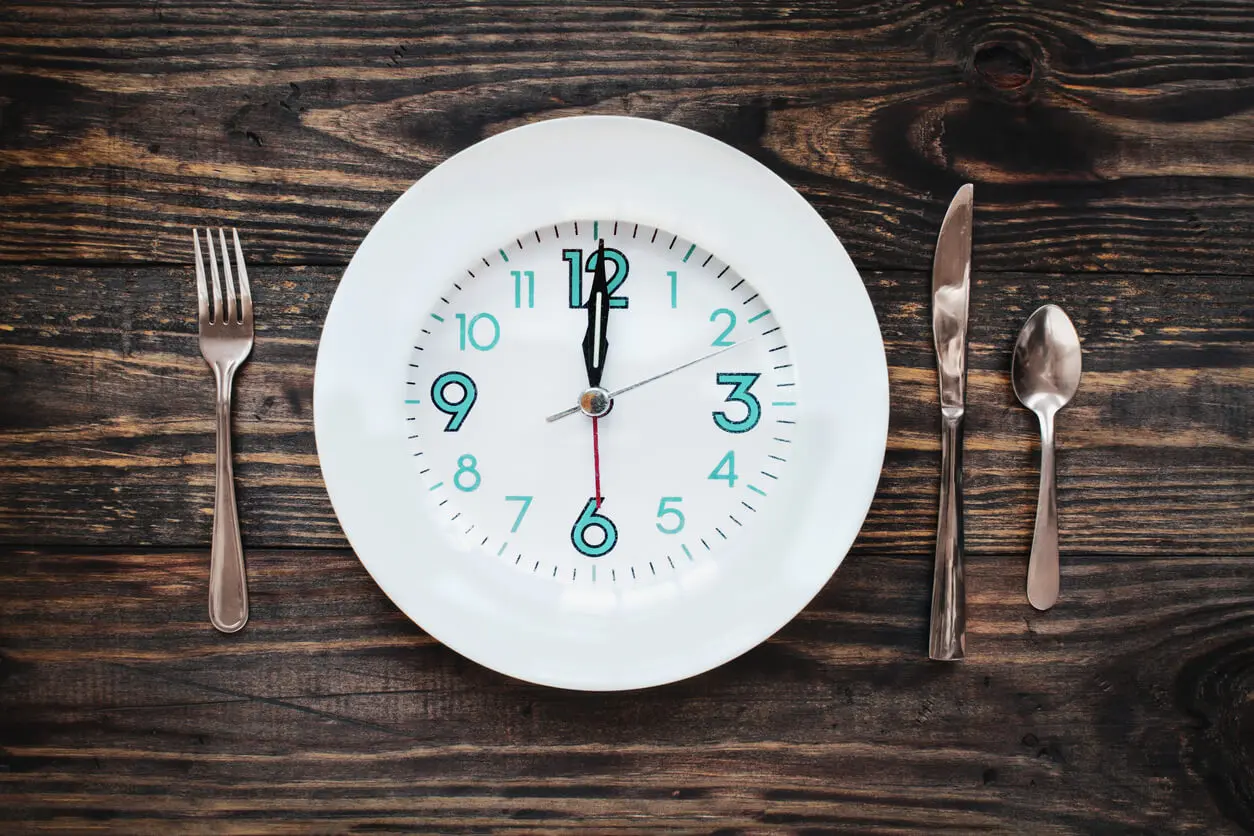10 Different Ways to Try Intermittent Fasting


Written and verified by the nutritionist Maria Patricia Pinero Corredor
Weight loss can be challenging, as restrictive diets are emotionally draining and difficult to stick to. Fortunately, intermittent fasting is currently one of the most popular ways to lose weight. In fact, many of its followers also recommend it for better health and longevity.
Fasting has been practiced for religious purposes throughout history. However, in this case, intermittent fasting (IF) is a type of dietary restriction that is applied to lose weight quickly and in regular cycles.
Intermittent fasting includes a variety of eating patterns or types of eating. The restriction occurs for specific periods of time on a repetitive basis.
According to the journal Obesity, there are four common patterns of intermittent fasting. Some of them are subdivided into several types.
For each pattern, there is a redistribution of the times at which we will eat our meals during the day. In addition, it’s necessary to consider your daily activities such as work, studies, and exercise, among others.
This will allow you to feel comfortable and satiated to avoid any binge eating. During fasting, no food or drink that represents a caloric intake is ingested. However, hydrating liquids and non-caloric stimulants are allowed, such as water, tea, coffee, or infusions.
Now let’s take a look at some of the ways you can adopt intermittent fasting.
We think you may also enjoy reading this article: A Vegetarian Diet for Children: Advantages and Disadvantages
Intermittent fasting according to a time-restricted eating pattern
This pattern includes those methods in which fasting can go from 8 to 16 hours in the day. Let’s take a look.
1. Fasting 12/feeding 12
In these forms of intermittent fasting, the fasting and feeding periods are 12 hours each. This is also known as 12/12.
Some studies conclude that 12 to 18-hour fasts allow the utilization of fat as a source of energy. Ketones are released into the blood which stimulates weight loss, improves insulin sensitivity, and lower blood pressure.
This type of diet becomes a good option for beginners. The fasting time is short when compared to others and sleep hours are included.
An example is that if the fasting window is between 7 p.m. and 7 a.m., dinner should be finished before 7 p.m. After this time, fasting begins. Most of the time, the person will be sleeping during this fasting period.
2. Fasting 16/eating 8
This fast is known as the lean gains protocol, 16:8 or 16/8 diet. It’s a popular method and, like the 12/12, most of the fasting window is included in the sleeping hours. So, you really just need to skip breakfast to get your 16 hours.
Your next meal would be lunch. You can eat between 11 a.m. and 7 p.m., or between 12 a.m. and 8 p.m. to meet caloric requirements. The most popular eating windows are as follows:
- 7 a.m. to 3 p.m.
- 9 a.m. to 5 p.m.
- 12 p.m. to 8 p.m.
- 2 p.m. to 10 p.m.
Even if you skip breakfast, you can still eat a balanced lunch and dinner accompanied by a few snacks throughout the day. If you want to eat breakfast, you can do so at 9 a.m., followed by a standard lunch at noon and an early dinner.
The foods that will be part of your 16/8 method should be healthy. If you eat processed foods that are high in calories and low in nutrients, your diet won’t work.

3. Fasting 14/feeding 10
This type of fasting is as popular as the 16/8, only it takes into account a 14-hour fasting period. The feeding window should be between 2 or 3 meals during a 10-hour time period.
For example, your first meal can be at 10 a.m. as breakfast, at 4 p.m. lunch, and then at 8 p.m., you can enjoy dinner or a snack. The fasting window can then run from 8 p.m. to 10 a.m.
Don’t forget that this schedule is only a suggestion – you can adapt the schedule to your needs.
Intermittent fasting according to the alternate-day pattern
Another variant of intermittent fasting is to consider full days of restriction. Here, there are two options.
4. Alternate fasting (AA)
This type of intermittent fasting involves fasting every two days – i.e., no solid food on those days. In the feeding windows, freedom is given to eat whatever you want.
On the effectiveness of this type of AI, a 2018 review concluded that alternate fasting is effective for weight loss more than restrictive dieting in overweight and obese adults.
However, a clinical trial published that alternate-day fasting did not produce differences in weight loss or weight maintenance. Nor did it achieve a cardioprotective function when compared to restrictive diets.
This is considered a very extreme way for beginners to apply intermittent fasting. In addition, it’s somewhat unpleasant to maintain it in the long term.
5. Alternating 24-hour fasting
According to Yavelow’s team at the University of Florida, in this type of IF the person fasts for 24 hours and then has a full day of unrestricted eating. In this way, he/she alternates between eating one day and not eating the next.
During the feeding days, regular meals should be eaten and during the fasts infusions, coffee or mineral water are included. It’s advisable to start with time-restricted fasts such as 14/10, before proceeding to the 24-hour fast.
Like this article? You may also like to read: What Are Water Chestnuts and How Can They Be Included in Your Diet?
6. Modified fasting pattern with alternating days
Obesity magazine does not subdivide this eating pattern. This is similar to AA in terms of timing, but with certain modifications. The difference is that 25% of the caloric requirement is allowed to be consumed on the fasting day. This is equivalent to 500-600 calories.
7. Periodic intermittent fasting pattern
Yavelow’s team explains that the fasting window is given for 1 or 2 days a week, in this case, allowing 25 % of the caloric requirement. The rest of the week unrestricted feeding is applied.
It is important to maintain a regular diet during the feeding days, especially if weight control is the goal. Anyway, fasting 24 full hours can cause irritability, headaches, and fatigue.
Other variants of intermittent fasting
Beyond the 4 patterns recognized by science, there are some alternatives.
8. Skipping some food during the day
This is a flexible and spontaneous type of intermittent fasting that’s ideal for beginners. It doesn’t have to be daily.
A good place to decide when to fast could be according to time constraints, work, or depending on your level of hunger. No matter what, it’s mandatory to maintain a healthy diet.

9. The 5:2 diet
On the 5:2 diet, you can eat what’s part of your regular diet for 5 days a week. For the remaining two days, you will have a caloric intake of 500 calories for women and 600 calories for men.
Women are able to eat 2 small portion meals at a rate of 250 calories each. Meanwhile, men can eat 2 servings of 300 calories at each meal. In the magazine The American Journal of Clinical Nutrition they highlight the benefits of the 5:2 diet in promoting significant weight loss in adults of both sexes between the ages of 35 and 65.
10. The Warrior Diet
The Warrior Diet is considered one of the most extreme forms of intermittent fasting. Small portions of raw fruits and vegetables are eaten throughout the day in a 20-hour fasting time. The feeding window is usually loaded with a large meal, only for about 4 hours at night.
It’s recommended to have experience with other forms of intermittent fasting to start it. Its followers defend it by saying that early humans were likely nocturnal eaters, so this diet would be in harmony with their circadian rhythms.
During the 4 hours you can eat, you should ensure balance, balance, sufficiency, and the quality of your meals while not forgetting carbohydrates and healthy fats.
The foods are similar to those used in the Paleo diet, especially when including unprocessed whole grain products. Sometimes, it’s a little tricky to eat so much when it’s so close to bedtime.
Responsible fasting to take care of your health
Intermittent fasting is not a magic diet in any way. It can’t solve extreme weight gain or obesity problems all at once. Also, some people should not do it – for example, those with eating disorders.
It’s also crucial that during your feeding window, your menu is made up of healthy and balanced meals. Finally, whenever you ar doing intermittent fasting, you should be accompanied by a health professional to advise you.
All cited sources were thoroughly reviewed by our team to ensure their quality, reliability, currency, and validity. The bibliography of this article was considered reliable and of academic or scientific accuracy.
- Kritchevsky, Stephen B., Kristen M. Beavers, Michael E. Miller, M. Kyla Shea, Denise K. Houston, Dalane W. Kitzman, and Barbara J. Nicklas. 2015. “Intentional Weight Loss and All-Cause Mortality: A Meta-analysis of Random – ized Clinical Trials.” PloS one 10 (3): e0121993–e0121993. https://doi.org/10.1371/journal.pone.0121993
- Anton, Stephen D., Keelin Moehl, William T. Donahoo, Krisztina Marosi, Stephanie A. Lee, Arch G. Mainous III, Christiaan Leeuwenburgh, and Mark P. Mattson. 2018. “Flipping the Metabolic Switch: Understanding and Applying the Health Benefits of Fasting.” Obesity 26 (2): 254–268.
- Sutton, Elizabeth F., Robbie Beyl, Kate S. Early, William T. Cefalu, Eric Ravussin, and Courtney M. Peterson. 2018. “Early Time-Restricted Feeding Improves Insulin Sensitivity, Blood Pressure, and Oxidative Stress Even without Weight Loss in Men with Prediabetes.” Cell Metabolism 27 (6): 1212–1221.e3
- Angela, Tacinelli. Division of Agriculture. Research and Extension. Intermittent Fasting and Time-Restricted Feeding. Disponible en: https://agcomm.uark.edu/nutrition/Intermittent-Fasting_Time-Restricted-Feeding.pdf.
- Harris, L., Hamilton, S., Azevedo, L.B., Olajide, J., de Brun, C., Waller, G., Whittaker, V.J., Sharp, T., Lean, M.E., Hankey, C.R., & Ells, L.J. (2018). Intermittent fasting interventions for treatment of overweight and obesity in adults: a systematic review and meta-analysis. JBI Database of Systematic Reviews and Implementation Reports, 16, 507–547.
- Trepanowski, J.F., Kroeger, C.M., Barnosky, A.R., Klempel, M.C., Bhutani, S., Hoddy, K.K., Gabel, K., Freels, S., Rigdon, J., Rood, J.C., Ravussin, E., & Varady, K.A. (2017). Effect of Alternate-Day Fasting on Weight Loss, Weight Maintenance, and Cardioprotection Among Metabolically Healthy Obese Adults: A Randomized Clinical Trial. JAMA Internal Medicine, 177, 930–938.
- Patterson RE, Laughlin GA, LaCroix AZ, Hartman SJ, Natarajan L, Senger CM et al. Intermittent Fasting and Human Metabolic Health. Journal of the Academy of Nutrition and Dietetics. 2015 Aug 1;115(8):1203-1212. https://doi.org/10.1016/j.jand.2015.02.018
- Michelle Yavelow, Daniela Rivero-Mendoza, y Wendy J. Dahl. Dietas populares: Ayuno intermitente. Servicio de Extensión Cooperativa de la Florida, Instituto de Alimentos y Ciencias Agrícolas, Universidad de la Florida. (UF/IFAS). Fecha de primera publicación: octubre 2020. Visite nuestro sitio web EDIS en https://edis.ifas.ufl.edu
This text is provided for informational purposes only and does not replace consultation with a professional. If in doubt, consult your specialist.








